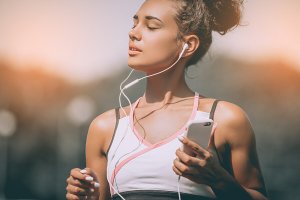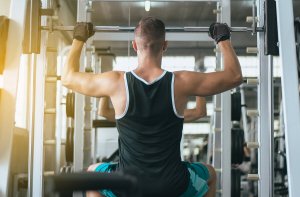How to Use your Hormones for More Productive Training

Hormones are produced by our bodies to achieve an immense amount of natural processes. Still, many times we’re not aware of exactly how those hormones work, and we don’t take advantage of them. That’s why in the following article, we’ll explain how you can take advantage of your natural hormones to train better.
Hormones and training
When we talk about hormones and their relation to exercise, we’re referring to the natural production of hormones, both in men and women. There’s a lot of misinformation on the matter of hormones and how our bodies produce them.
A great myth surrounding hormones is that they suddenly become ‘masculine’ when you develop muscles. This isn’t true, in any way, shape or form. The truth is that hormones work differently in men and women. Female and male bodies have different needs, and so, hormones are produced with different purposes.
For example, a man produces up to 20 times more testosterone than a woman; that’s why it’s easier for men to gain muscle. However, that doesn’t mean that females are at a disadvantage, as they can release more growth hormone or be more sensitive to anabolic hormones.
Read more: Macronutrients: Types and Their Benefits
Another issue that we must take into account is that it’s easier for men to lose what they have achieved when they stop training. On the other hand, women remain fit for a slightly longer period of time. Why? Because women can store proteins and glycogen in their muscles for longer.
There are many other curious facts regarding the role of hormones in both males and females. Women need a larger dose of energy, accumulate more fat but degrade their muscles less. Most of the time, females don’t need as many proteins or carbohydrates as males to maintain muscle mass.

How to use your hormones to train better
This article focuses mainly on women, and how their bodies produce hormones. During the menstrual cycle, hormones play a very important role in how their bodies behave. This doesn’t mean that men don’t have hormonal changes, but theirs fluctuate less.
The impact of your diet and training on your body will vary depending on which of the three phases of the cycle the woman is experiencing. Therefore, if you want to take advantage of your hormones to train better, you have to know how your cycle works.
1. Follicular phase
This begins after menstruation is complete. During this stage, women are more sensitive to insulin, they tolerate carbohydrates better, and they use glycogen more as an energy substrate. This means fewer calories and fats are being burnt and your metabolism is slower.
It’s the best time to train and in which the results of the exercise will be seen more quickly. In this stage, high intensity routines are recommended, which will counteract the metabolic descent of those days.
2. Ovulatory phase
It’s the central phase of the cycle when the ovum ‘travels’ to the uterus to be fertilized. During the ovulatory stage, the appetite is greatly reduced and the metabolism rises gradually. You have less appetite because the mind is busy focussing on procreating, not on eating.
A slight increase in strength is also experienced due to the hormone testosterone, and there may be more injuries than during the other phases. The latter is because you don’t feel fatigued, the consequences of hard training are not measured. It’s an ideal time to do strength exercises.

3. Luteal phase
The most complicated phase in the menstrual period, before and during bleeding. The first ‘symptom’ is an increase in appetite (you can even consume 500 calories more each day) and the metabolism accelerates.
Likewise, fat is used more as a fuel, tolerance to carbohydrates is lower, and so is your sensitivity to insulin. At the same time, the decrease in progesterone results in less serotonin. As a result, moodiness, irritability, and headaches are frequently experienced.
You might also like: 7 Effective Tips to Overcome Food Guilt
On the other hand, due to the loss of blood, the transport of oxygen to the muscles can be reduced, and that impacts upon performance. As this happens, you shouldn’t skip your gym sessions entirely, but only reduce the intensity of your training. We recommend that you focus on your cardio sequences.
In short, don’t hesitate to use your hormones to improve your training routines. Always take into account your cycle and the specific needs of each phase. Follow these guidelines and strengthen your work sessions!
Hormones are produced by our bodies to achieve an immense amount of natural processes. Still, many times we’re not aware of exactly how those hormones work, and we don’t take advantage of them. That’s why in the following article, we’ll explain how you can take advantage of your natural hormones to train better.
Hormones and training
When we talk about hormones and their relation to exercise, we’re referring to the natural production of hormones, both in men and women. There’s a lot of misinformation on the matter of hormones and how our bodies produce them.
A great myth surrounding hormones is that they suddenly become ‘masculine’ when you develop muscles. This isn’t true, in any way, shape or form. The truth is that hormones work differently in men and women. Female and male bodies have different needs, and so, hormones are produced with different purposes.
For example, a man produces up to 20 times more testosterone than a woman; that’s why it’s easier for men to gain muscle. However, that doesn’t mean that females are at a disadvantage, as they can release more growth hormone or be more sensitive to anabolic hormones.
Read more: Macronutrients: Types and Their Benefits
Another issue that we must take into account is that it’s easier for men to lose what they have achieved when they stop training. On the other hand, women remain fit for a slightly longer period of time. Why? Because women can store proteins and glycogen in their muscles for longer.
There are many other curious facts regarding the role of hormones in both males and females. Women need a larger dose of energy, accumulate more fat but degrade their muscles less. Most of the time, females don’t need as many proteins or carbohydrates as males to maintain muscle mass.

How to use your hormones to train better
This article focuses mainly on women, and how their bodies produce hormones. During the menstrual cycle, hormones play a very important role in how their bodies behave. This doesn’t mean that men don’t have hormonal changes, but theirs fluctuate less.
The impact of your diet and training on your body will vary depending on which of the three phases of the cycle the woman is experiencing. Therefore, if you want to take advantage of your hormones to train better, you have to know how your cycle works.
1. Follicular phase
This begins after menstruation is complete. During this stage, women are more sensitive to insulin, they tolerate carbohydrates better, and they use glycogen more as an energy substrate. This means fewer calories and fats are being burnt and your metabolism is slower.
It’s the best time to train and in which the results of the exercise will be seen more quickly. In this stage, high intensity routines are recommended, which will counteract the metabolic descent of those days.
2. Ovulatory phase
It’s the central phase of the cycle when the ovum ‘travels’ to the uterus to be fertilized. During the ovulatory stage, the appetite is greatly reduced and the metabolism rises gradually. You have less appetite because the mind is busy focussing on procreating, not on eating.
A slight increase in strength is also experienced due to the hormone testosterone, and there may be more injuries than during the other phases. The latter is because you don’t feel fatigued, the consequences of hard training are not measured. It’s an ideal time to do strength exercises.

3. Luteal phase
The most complicated phase in the menstrual period, before and during bleeding. The first ‘symptom’ is an increase in appetite (you can even consume 500 calories more each day) and the metabolism accelerates.
Likewise, fat is used more as a fuel, tolerance to carbohydrates is lower, and so is your sensitivity to insulin. At the same time, the decrease in progesterone results in less serotonin. As a result, moodiness, irritability, and headaches are frequently experienced.
You might also like: 7 Effective Tips to Overcome Food Guilt
On the other hand, due to the loss of blood, the transport of oxygen to the muscles can be reduced, and that impacts upon performance. As this happens, you shouldn’t skip your gym sessions entirely, but only reduce the intensity of your training. We recommend that you focus on your cardio sequences.
In short, don’t hesitate to use your hormones to improve your training routines. Always take into account your cycle and the specific needs of each phase. Follow these guidelines and strengthen your work sessions!
All cited sources were thoroughly reviewed by our team to ensure their quality, reliability, currency, and validity. The bibliography of this article was considered reliable and of academic or scientific accuracy.
- Centro Provincial de Información de Ciencias Médicas de Camagüey, Aguilar S, M. M., & A., Q. (2017). La mujer, el ciclo menstrual y la actividad física. Revista Archivo Médico de Camagüey.
This text is provided for informational purposes only and does not replace consultation with a professional. If in doubt, consult your specialist.








